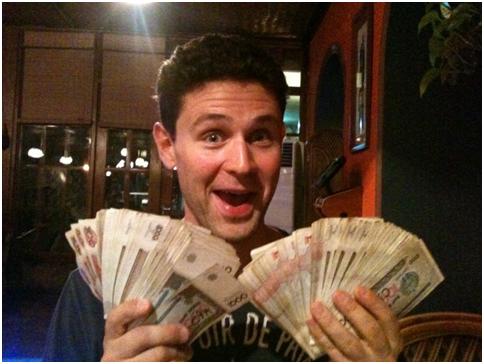Some of you may remember a previous post about the corporate lawyer we met in Cuzco, choking down pizza with one hand in one of the best restaurants in town while frantically blackberrying his holiday away trying to keep tabs on a live transaction. It made us both desperately sad, and rather glad – sad that we had ruined so many of our own holidays doing exactly that, and glad that we didn’t have to let deals interrupt our dinners, at least not on this trip.
Or so we thought. We are in Tashkent, and we have run out of money. Not truly run out of money, mind. We still have a little stashed away in our home bank accounts, and we had recently tracked down a bizarrely incongruous branch of the Royal Bank of Scotland which had given us a small but crisp stack of US dollars. Our money belts were happily replete: those US dollars; some Renmimbi for when we reach the ATM-free far west of China in 10 days’ time; some leftover Hong Kong dollars for our return there in October; and some randoms – a few Euro, some leftover Aussie dollars, a taxi fare’s worth of Japanese Yen and a few Solomons and Bolivianos we had been unable to exchange back when we left those countries. And of course we also carry emergency travelers cheques just in case. But we didn’t have enough Uzbek Som, and this was a problem.
The Uzbek Som is a funny beast: the official exchange rate stands at about 2,000 to the dollar but black market rates are much higher, no doubt because of the rampant inflation in the country that rapidly depletes the savings of any Uzbek patriotic enough to keep their nest egg in local currency. As a result of this gap, almost nobody takes credit cards and there are virtually no foreigner-friendly ATMs – nobody would use them, as they would be pinned to the unattractive official exchange rate. As a result, travel cash in Uzbekistan is still done the way it was when I travelled in India in 1994 – queue up once a week to withdraw dollars from a bank teller and exchange them either at the bank or through some dodgy chap in sunglasses on a street corner. Oh, and add to this the fact that the largest denomination is the 1,000 Som note (worth about 40 cents) making $100 in Som literally about an inch thick (and by “literally” I mean “literally”).
So cut back to dinner – I had reached into my painfully bulging trouser pocket (no, not like that) and counted out my stack of Som (there is a special rapid counting technique, and now I have practiced it I could pass for a used car salesman in the UK). We had enough for a vegetarian dinner or wine, but not both, and we had had a really bad day. We were on the point of rediscovering the excellence of Georgian red wine (hi Dato!) and, faced with the choice of soda water or no dinner, I asked the waitress if they accepted dollars. The answer was unfortunately no (it is, after all, illegal) but they knew a man who could…
So this was the business deal that interrupted our dinner. After a couple of quiet conversations with the doorman, he arranged for a taxi driver friend of his to come, pick up an unmarked $50 note, drive away again, change the cash and come back. Interestingly, if unsurprisingly, the nighttime black market rate is a little worse than the daytime black market rate, but $50 is still enough for a good bottle of dry Georgian red wine.
And it led to yet another great life experience – you are sitting at dinner drinking wine with your lovely fiancée when a man enters, scans the restaurant, makes eye contact and walks over. He stops by your table, subtly slips you a half-inch thick slab of bank notes, bows slightly (with his hand on his heart, in the central Asian fashion) and walks away. Tonight, I am the Godfather.

The Godfather pays for dinner – about $80 for two, with wine

Just got caught up on the latest round of postings (current back to this one) – off to make a cucumber martini and see if London has any eagles. But the mental image of this guy bowing to you is as good as any in the background gallery. Pls keep gallivanting and writing amusingly about.